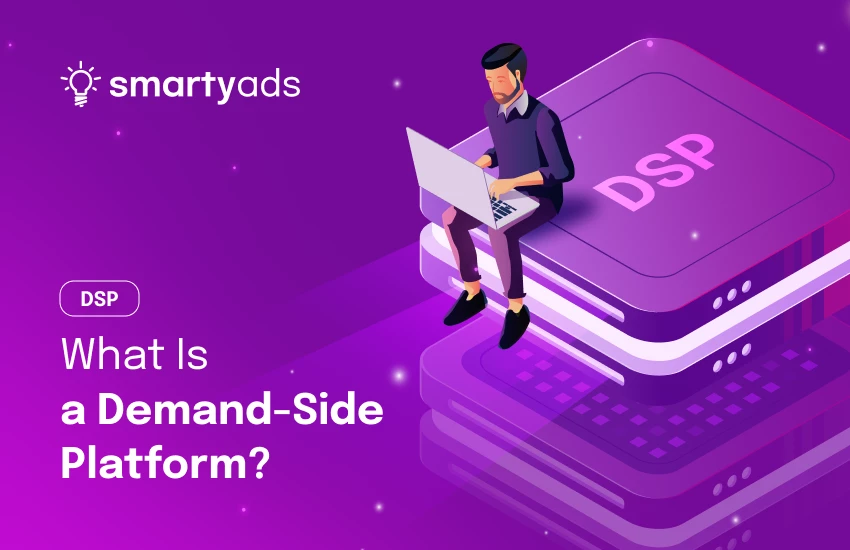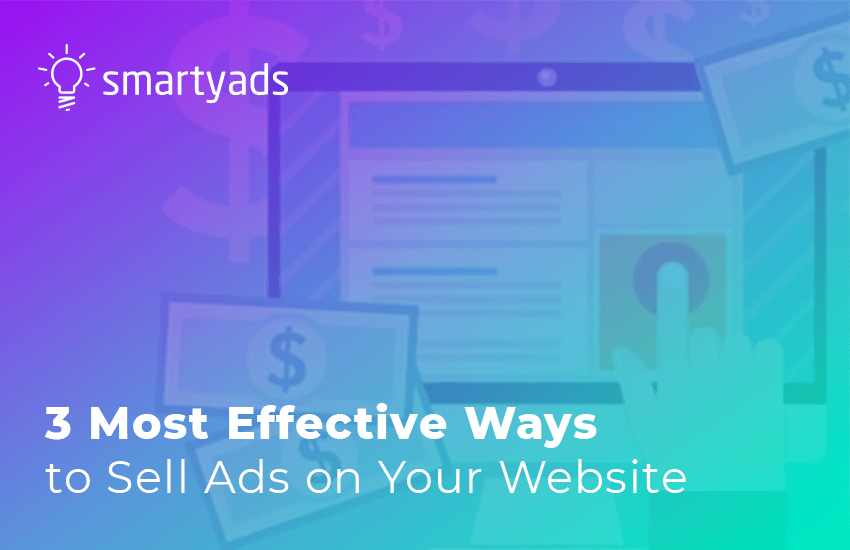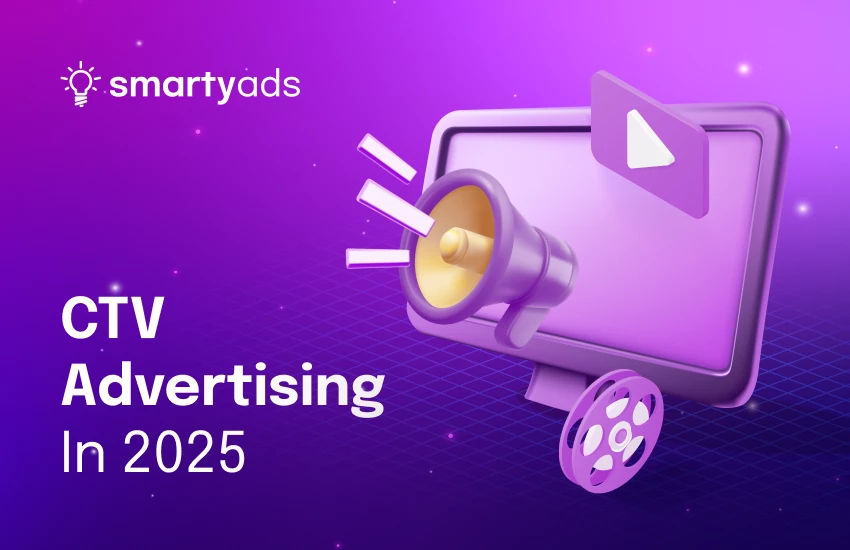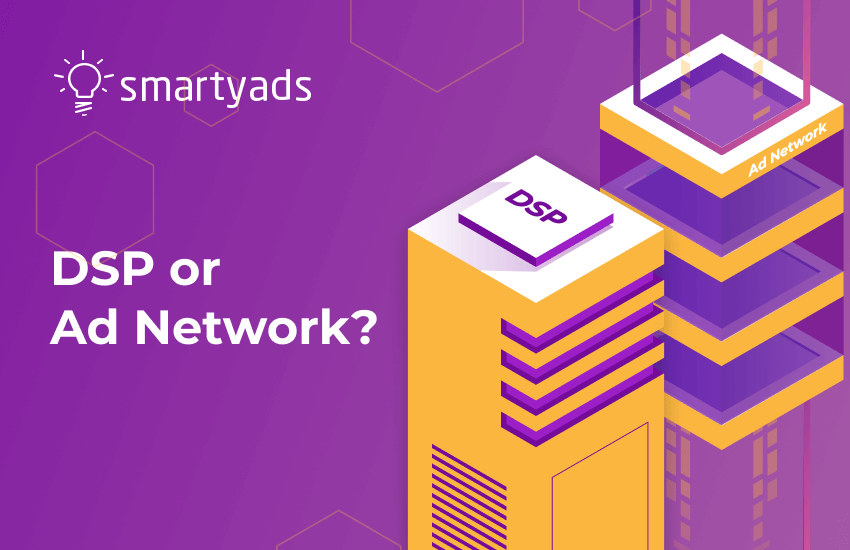The accuracy and efficiency that big data brought to our lives are now changing the landscape of media buying. Thanks to big data, the object of demand today is the target audience instead of the advertising space itself. Thus, those advertisers who have access to the demand-side platform have access to the tool that makes this data work.
DSP advertising helps brands find their perfect customers, regardless of the platform, device, or screen they’re using. It provides an opportunity to understand how they interact with the ad before they purchase the product online and predict their behavior in the future.
In this article, we are going to dive into all the peculiarities of a demand-side platform. Keep reading to explore the answers to the following questions: what is a DSP in advertising, what are its benefits, and how to get the most out of this technology? Let’s get started!

What is a demand-side platform?
DSP stands for Demand-Side Platform, a software that is used for programmatic ad buying, typically via bidding in RTB auctions. The purpose of the DSP is to buy the impressions on the suitable inventory and show them to the users that meet the target requirements for the optimal (minimum) price.
DSPs are commonly used by advertisers, in-house marketing teams, advertising agencies, or Agency Trading Desks (ATDs). Utilizing DSPs, media buyers get access to multiple SSPs, Ad Exchanges, and Ad Networks through a single interface, allowing them to purchase rich media, video, mobile, and native ads in real time. The process of buying inventory is performed automatically within seconds, making the trading less time-consuming and much more profitable.
Let's find out the difference between DSP vs SSP advertising. DSPs are the flip side of SSPs (Supply-Side Platforms). SSP is a technological platform that represents the interests of the publisher and sells advertising inventory. The DSPs transmit the bids from advertisers along with inventory requirements to SSPs. When the winner of the RTB auction is defined, the interests of both parties (advertiser and publisher) are taken into account.
What was wrong with manual placing?
In the early days, digital ads were bought and sold by ad buyers and salespeople. DSPs were designed to minimize the need for negotiations between media buyers and publishers, making the process cheaper and more efficient with automation. With the appearance of DSPs, the need for manual deal negotiation has completely vanished.
Buying ad space in real time through DSPs gives advertisers the opportunity to run ad campaigns to the target audience at the right time, screen, and ad format.
The power of the DSP is in its ability to automate the decision-making process: decide which impression to bid on and calculate the maximum value of each impression. During the RTB auction, the system programmatically sorts off impressions and defines the highest bidder. The winning bidder pays the price determined by the second-price auction: not the actual highest price but the second-highest bid offered, plus $0.01. That’s how the fair price defined by this mechanism prevents the advertiser from overpaying.
What is the difference between DSP and ad network?
Indeed, demand-side platforms at times offer the same features as ad networks do; targeting and the ability to reach a large pool of potential resources are among them. The fact that most DSPs offer a single tool for the ad campaign launch, optimization, and analysis gives them a significant advantage over ad networks that don’t have all-in-one functionality. Thus, DSPs do not add margins to the inventory. Instead, they charge a fee only when a transaction takes place.
After some time, both DSP platforms and ad networks found a way to benefit from the situation without losing service quality. Ad networks adjusted RTB bidding opportunities, while DSPs are also buying the premium inventory and reselling it with added margins.
How does a demand-side platform (DSP) work?
Defining the game rules. We’ve just found out what demand side platform software is, and it’s time to get a little bit more nerdy to understand how it works. By using the DSP campaign-building tool, an advertiser provides parameters about the desired target audience, such as gender, age, location, annual income, etc.
Do you want to distribute the budget evenly throughout the day? Here you go; the “Daily cap” option allows you to distribute the budget throughout the day. The “lifelong pacing” option permits even budget distribution over the lifetime of the ad campaign. Want to make sure your ads are shown only on good-quality websites? Block web pages with sensitive content, create the white and blacklists of publishers you’d want to deal with or avoid forever.
All the manipulations, configurations, tuning, and optimizations are up to the advertiser; after all, that’s why this thing is called a self-served demand-side platform. There are also managed-service DSPs and full-service DSPs explicitly designed for advertisers who feel that their expertise is insufficient and who need support during campaign management.
How RTB bidding happens. Top DSP platforms analyze each inventory to decide whether it is valuable for the advertiser and whether it fits the requirements and targeting settings. If it does, the DSP automatically calculates the maximum cost of that inventory and sends the bid response back to the exchange. The price of a bid is based on the advertiser’s pre-set budgeting data and user information such as location, demographics, and browsing behavior. Due to machine learning algorithms and prediction mechanisms, the analysis of the ad impression takes milliseconds.
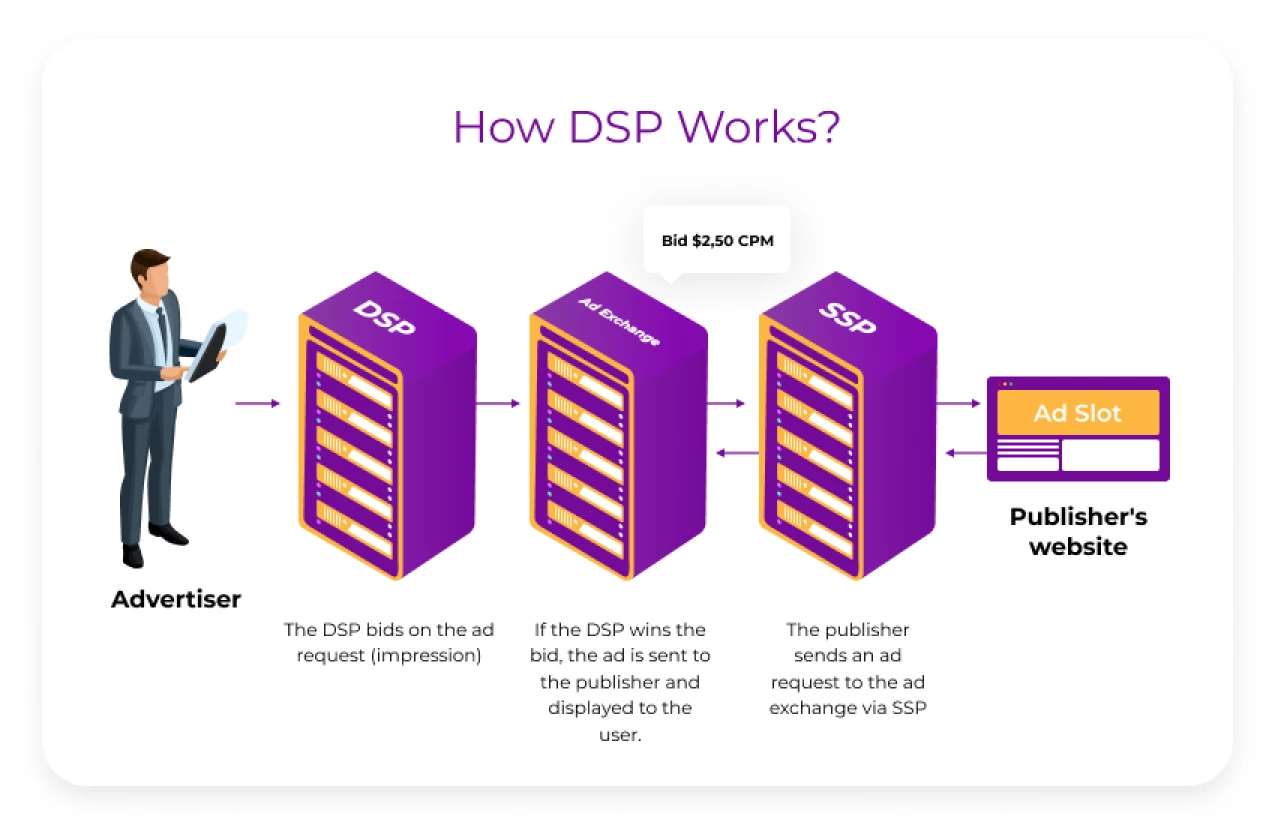
Types of demand-side platforms
Self-serve DSPs
Self-serve DSPs allow advertisers to manage their campaigns autonomously. These platforms feature intuitive and easy-to-use dashboards and tools for building ad placements, setting ad pricing floors, targeting audiences, adjusting CPM, and optimizing and analyzing campaigns in real time. Perfect for businesses with an in-house marketing team, as DSPs offer exceptional flexibility and control.
Full-service DSPs
Full-service DSPs can be suitable for potential advertisers without an in-house team but who still want to receive programmatic ad-buying services. A dedicated team will handle everything from strategy to execution, making these platforms perfect for businesses that lack the resources or expertise to manage campaigns on their own.
Emerging specialist DSP categories
Mobile DSPs
What is mobile DSP: mobile DSPs focus on delivering ads to smartphone and tablet users. They offer a wide variety of ad formats that will fit any target audience and marketing objectives to smoothly launch mobile ad campaigns.
Video DSPs
This type of DSP focuses on serving video ads across platforms like YouTube and in-app environments. They support high-quality formats to provide the best viewer experience and deliver impactful visual storytelling.
CTV DSPs
Connected TV or CTV DSPs are gaining more popularity and are tailored specifically for programmatic advertising on smart TVs and streaming devices. With advanced features and premium inventory, they enable advertisers to reach engaged audiences in the evolving CTV landscape.
Why do media buyers use DSP in advertising?
1. Global reach and integration
Most DSPs integrate with RTB Exchanges; however, some of them provide access to premium or high-class inventory while others don’t. Some DSPs are connected to global Ad Exchanges, whereas others start partnerships with local premium publishers only.
Almost all DSPs give access to a range of inventory worldwide on desktop and mobile screens and allow DSP media buying in multiple currencies. When choosing a DSP, it is important to find out beforehand what traffic verticals and ad formats the DSP supports.
2. Effective targeting
The definition of a demand-side platform would be incomplete without targeting. This function utilizes the user data to make the message as relevant to the viewers as possible.
DSPs can target:
- according to the geolocation, county, city, time zone;
- according to gender, marital status, income, level of education, language, and interests (this is extended targeting enabled by integration with DMP, which aggregates first, second, and third-party data);
- according to the device (desktop, mobile, tablet).
Such options as frequency capping (how often the same ad appears in front of the same user) and dayparting strategy (which part of the day) make DSP digital advertising even more individualized. The cookie-level retargeting will help find the users who once visited your website but didn’t convert and remind them about the offer.
Each RTB DSP platform may use different kinds of data, like unique first-party data or third-party data collected from DMPs (Data Management Platform). DSPs may integrate with DMPs, and this way, they can access additional audience data essential for campaign optimization and retargeting.
Some DSPs focus mainly on CRM data, whereas others specialize only on mobile data. Hence, before choosing a DSP, it is crucial to find out what data your DSP uses, which segments it focuses on, and how big the reach is for those segments.
3. Right inventory and brand safety
The first thing that determines the success of RTB campaigns is the inventory choice. Since the DSP platform allows to pre-define the type of inventory for purchasing, it’s easier to aim for success. For instance, in-app DSP ads typically have higher engagement rates than mobile or desktop. Knowing such a fact, the brand that strives to raise engagement can choose to serve impressions only in apps.
Another example is the brand that wants to promote the new mobile game. The logical step will be to show the creative in other apps since the product is not working on the desktop.
As for brand safety, by adding some of the applications to the whitelist, the advertiser can shorten the inventory selection period, immediately posting on the sites with the highest performance. The blacklist, on the contrary, can eliminate inefficient inventory or block fraudulent or potentially harmful sources for the safety of your brand’s image.
4. Reporting and campaign analytics
Demand-side platforms allow advertisers to track the performance of their ad campaigns in real time. Most DSPs offer granular statistical reporting on click-through rates, website traffic, page views, engagement rates, and more.
Regardless of the fact that the ad campaign runs across different Ad Exchanges at the same time, a DSP gathers information from all sources. After this, it delivers it as a consolidated custom report. Reporting helps to see what works and what doesn’t and to define a strategy for future campaigns more effectively.
5. Minimal budget
DSP advertising allows small and medium brands to launch and customize their advertising campaigns. This move reduces the extra costs typically consumed by third-party service providers. Most DSPs make it possible to start a campaign with a couple of hundred dollars on personal balance.
It’s worth noting that every Demand-Side Platform has its own pricing model. DSPs work on CPM, CPA, CPE, CPI or a CPC basis, each of which has its own specifics of calculation. As a rule, CPM (cost per mille) is one of the most widespread. In such a model, the payment is counted per thousand impressions.
Since the DSP platform is bidding each time on a different impression, the payment is distributed evenly after each impression served, not 1000 impressions at once. The auctions run according to the second-price auction. The winning bidder pays the second-highest bid for inventory plus $0.01 (not the actual highest winning price).
The critical thing to remember is that the pricing models featured above do not contradict each other. Those are the parallel directions that can effectively complement and reinforce each other for the majority of programmatic media buying ad campaigns. 
Benefits of a demand-side platform (DSP)
Here are some demand side platforms important advantages that will convince you to try them out.
Real-time bidding
This platform makes it possible for advertisers to bid for specific ad placement in real time and optimizes ad spending based on ad performance and preferred targeting.
Top-notch inventory
You can access premium inventory so your ad is published on top resources that enhance your marketing efforts instead of compromising your brand image.
Advanced targeting options
DSPs usually offer granular targeting based on demographics, location, behavior, and contextual targeting, enabling advertisers to tailor ads for each specific campaign and create a personalized experience.
High efficiency and automation
Most processes related to purchasing ad inventory, as well as other activities, can significantly save time and nurture higher efficiency.
Cross-channel strategy
You can effortlessly launch, run, and track ad campaigns across different channels (web, mobile, social media) from a single DSP dashboard, ensuring greater ROI and broader reach.
Exceptional transparency and reporting capabilities
A demand-side platform provides advertisers with detailed analytics and reporting and ensures transparent insights on campaign performance to make it possible to adjust strategies along the way.
Data integration
You can integrate a DSP with a wide range of third-party services to maximize your functionality and reach successful outcomes.
Dispelling the misconceptions of DSP marketing
It’s worth pointing out that working with the RTB DSP platform doesn’t mean having to deal with a remnant inventory. It’s correct only to some extent. For instance, picture yourself as a website owner; sure thing, you'll have specific priorities considering selling your best advertising space.
The higher the pricing you’re offering, the higher the chances you’ll give an advertiser the preference; the rest of the space could be commissioned to programmatic. Does it make the inventory worse in terms of quality? Absolutely not; this is the same top-notch space but without the purchasing volume guarantee.
How to choose the right demand-side platform
Independent
Look at the top demand-side platforms. It doesn’t take much time to figure out what makes them strong. First of all, those platforms have their technologies and in-house team of developers and engineers who constantly upgrade the product and improve their capabilities.
Unbiased
It is essential that the advertiser would be able to make decisions freely and choose a supplier of inventory and data independently. Only this way it is possible to achieve KPIs set by a particular advertiser. In other words, the perfect DSP platform is unbiased.
Customizable
What does it mean? As we already know, the RTB (Real-Time Bidding) ecosystem is an extensive network that includes key players like DSP, SSP, and DMP. While launching the ad campaign, the advertiser should be free to choose partners for collaboration. Similarly, it should be easy for the media buyer to exclude suppliers that perform worse than others while the campaign is running.
The list of demand-side platforms
Top demand-side platforms in 2020 not only strengthened their positions on the market but also revolutionized and added cutting-edge tech features to the functional set to stay competitive.
The necessity to support all-screen formats and optimization features is what drives renowned brands to custom demand-side platforms that can be fine-tuned individually. Technical augmentations and individualization, however, are not the only reasons for that.
The data ownership. Utilizing your own advertising DSP is about more freedom and control at the same time. Collected user data and technology belong to the brand, which means advertisers are free to leverage them to achieve high ad campaign performance. Personal user data management becomes less risky as there’s no need to entrust customer data to intermediaries, and there’s no room for data breach or loss.
Commission fee elimination. Since the DSP programmatic platforms include an enormous amount of intermediaries, such as AdTech providers, traffic arbitrators, and agencies (if involved), all of them consume a particular fraction of the advertiser’s budget. Running down the pipe, the budget disperses, and the publisher receives only half of the cost. Own DSP works transparently, eliminating third-party services; such a system removes the need for additional fees and commissions.
Summing it up
The main task of the demand-side platform is to provide the media buyer with a personal account, show all the capabilities of the built-in tools, and receive feedback. It is a win-win system: the advertiser gains professional skills, and the platform analyzes the data to understand the needs and expectations of the advertising market better.
Start growing your business easily by advertising on SmartyAds DSP!

